Mystique, experimentation at dance festival
By Peter Hernandez and Sara Bloomberg
The Guardsman
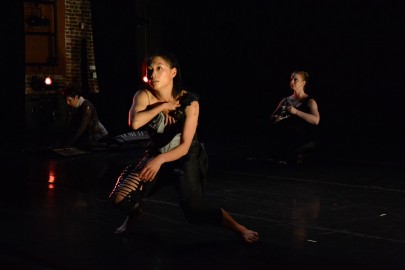
Spaghetti-flinging girls in pretty white dresses, tabletop Serbian dances, and dancers pausing to converse delighted ODC Theater’s first annual Walking Distance Dance Festival.
From June 29 to July 1, new trends and medias were seen in performances by some of the Bay Area’s most celebrated choreographers and dancers at their Mission District campuses. Whatever the medium, the message was always clear: Dance is changing, and ODC is at the vanguard of it.
DAY ONE: FRIDAY by Peter Hernandez
Before Benjamin Levy apologized by megaphone for starting his performance late, he made sure to kiss each of his dancers on the cheek as they huddled in an adjacent studio. The affection and intimacy foreshadowed what was about to happen in one of this weekend’s opening performances.
“I like the smell of moss and the sound of gushing water. That’s a direct quote from my online dating profile,” the Bay Area-native and UC Berkeley graduate said through his megaphone as his dance group playfully engaged in lively Serbian dances some ten minutes in, running around the audience, who were seated in what seemed to be randomly-placed chairs.
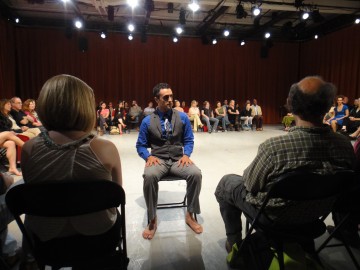
Dancers Scott Marlowe and Melodie Casta largely shared the spotlight with Levy through co-dependent dances that explored youthful group dynamics, which were later translated into interactions with the audience. While sitting in the audience, dancers gestured and giggled at their nearest audience member like teenagers sharing secrets. Dancers later serenaded the audience into a tango and then moved their folding chairs to accommodate a circular arrangement of tables, whereupon dancers posed like ice sculptures, cast under the white light of projectors in a smoke-filled room.
NEW ERA OF DANCE
Levy’s dance reflected a new era of dance performance wherein performance art, site-specific installations and commissioned avant-garde musical compositions converge, flinging the conventional dance piece like a five-pound bowl of spaghetti in Italian choreographer Alice Gosti’s dance piece, “Spaghetti CO. — Are you still hungry?”
The room smelled of tomato sauce in this part installation, part foodfight where Gosti’s trio of women investigated female relationships. The Seattle-based dance group tossed wine at each other’s faces, flung spaghetti across their tarp-enclosed dining room and then gently rested each other’s heads on plates of spaghetti. Like caged zoo animals, the dancers perked their heads curiously in unison and then settled into immobility.
“Spaghetti” was an unsettling vision of dance — there was a beauty in the spaghetti strewn on the ground and spilt wine that contrasted with the stationary women, posing on a small veneer table.
“Waving Not Drowning (A Guide to Elegance),” choreographed by Brenda Way for ODC/Dance, provided a fascinating reflection on vanity and self-worth. Though the dancers’ faces convey an extreme seriousness, Pamela Z’s spoken word accompaniment playfully reigns in the performance.
After a series of independent dances, largely in pairs with a repetitive vocal accompaniment by Z that became hypnotic, the female dancers created costumes for the stationary male dancers positioned in front of the audience.
After several minutes, an astonishing arrangement of men had been sculpted into ballerinas from white paper and masking tape. The audience was left with questions of elegance and gender. Can only women be elegant? And does a man have to adopt a feminine manner to be elegant?
OUT OF PLACE
“Les Sylphides,” choreographed by KUNST-STOFF’s Yannis Adoniou, was a half-hearted laugh at classical ballet. Choreographed to the most classical, orchestral music heard that night, the performance seemed to question the legitimacy of contemporary ballet through uninspired dancing and stubborn ill-fitting silk togas. Dancers constantly straightened their costumes as though tugging at ill-fitting prom dresses which frequently obscured their faces in no artistic fashion. The attitudes of the dancers didn’t help either. While several dancers moved listlessly as though mocking their performance, Adoniou made a headstand in the corner and the audience felt like they were watching a ballet class.
DAY TWO: SATURDAY by Peter Hernandez
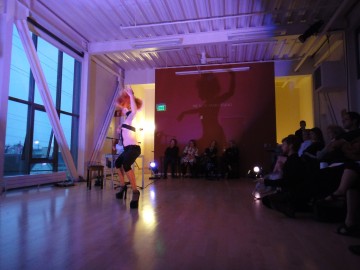
The second night of ODC’s weekend long festival tended toward tension, quarrels and love through dance form and even drag storytelling.
Monique Jenkinson’s “Faux Real” featured her own drag alter ego, Fauxnique, through a menagerie of ballet over Bauhaus and a stilt-like balancing act in six inch stiletto heels to Björk.Gazing into a vanity table mirror, she switched between lighting settings. “Office, daylight,” she mused.
“Faux Real” began with Jenkinson in a disproportionate pinstripe dress with pointy breasts and an oversized butt like a swollen and misshapen Bette Midler. Her charm enamored the audience through witty storytelling that alternated between high school prom stories and references to swanfighting.Her performance focused on imitation and authenticity and from a drag queen, the juxtaposition was laughable.
“Faux Real” managed to be a raucous drag show that paired the glamour commonplace amongst performers with a poignancy of experience and wit, which both engaged and amused.
“I’ve always liked the idea of punk, but actually I’m kind of a poseur,” said a nude Fauxnique behind her rack of costumes. Her self-awareness in the context of drag performance reconsidered the lines between performer and self.
PROPS FALL SHORT
Hope Mohr’s excerpt from her original production of “Reluctant Light” engaged a five-person dance group with six frames made from plastic pipes that evoked transparent cubicles. Mohr’s props suggested a study on proxemics, personal “bubbles” and domestic struggles. The execution, however, fell short of the promises of such a study with its impracticalities.
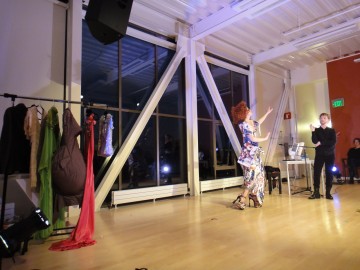
Dancer Roche Janken’s fluidity countered the stubbornness of the plastic frames, which were rattled and thrown across the stage. Like dogs jumping through hoops, the five dancers interacted with the frames ranging from three to six feet high with surprising grace.
The piece’s most dynamic duo, Justin Morrison and Tegan Schwab, explored an adversarial domestic environment within one of the spaces. Pushing, pulling and reconvening in the frame of the plastic pipes, they eventually shrunk into fetal positions within the frame.
RAWdance proved their athletic sensibility with “After 5:00,” in which they pulled at and tossed each other around like monkeys swinging through branches.The dance piece exhibited their physical strength and thoughtfulness — like when dancer Ryan T. Smith jaw-droppingly tossed Wendy Rein from one corner of the stage to the other again and again, or when he dangled her from his arms, always with sensuality and mild eroticism. But the message was lost in abstractions, like the water poured on each other from a glass bottle, or the mesmerized expressions they produced while watching each other from a sagging, misshapen couch.
RAWdance’s strength is seen more as an athletic spectacle than an artistic piece, but Smith and Rein will need to incorporate more speech or different props to convey their message about domesticity and romantic strife.
PLAYFUL LIGHTING
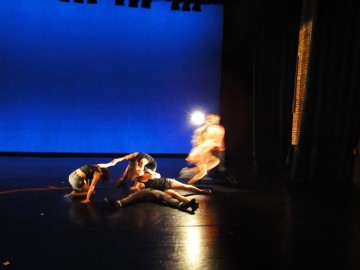
San Francisco-based Catherine Galasso exhibited an esoteric sensibility with her choreographies “Rebel Angels, Fall of the Rebel Angels: Study #1,” a portrait of today’s youth, and an excerpt from “Bring on the Lumière!,” a brilliant utilization of black and white film projection.
Galasso’s work showcased a multidisciplinary approach to dance, which was evident in “Lumière,” a Houdini meets Chaplin dynamic between dancers Christine Bonansea and Marina Fukushima, who dressed in suits with stuffed and oversized bellies. Their mime-like interactions referred to another era that is long gone and unattainable. Bonansea’s talent as an actress shined as she superimposed her own shadows onto a black and white projection of video that featured an infant taking its first steps.
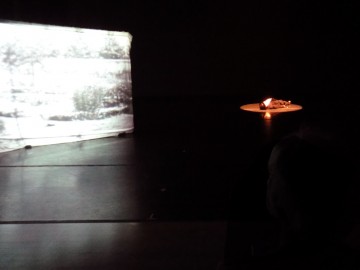
“Rebel Angels” was splashy and captivating, employing dancers in Converse sneakers and tank tops who looked like they came straight out of a Rihanna music video. The language used wasn’t necessarily English, yet conflicts and romances were apparent.Although a work in progress, “Rebel Angels’” athletic and combative dance movements captivated an audience far older than its dancers.
Using a handheld flood light, the dancers swiftly mounted and cascaded into a snake-like human pyramid, shifting into an amorphous gleeful human structure. Like teenagers in a photobooth, they emitted garbled words of delight and then shifted into another cascading human structure seconds later. It was like peering into a memento or a nostalgic moment paired with ambient vibraphone music.
Gabrielle Revlock’s “Halo” exclusively used a hula hoop to reference a long-gone childhood while reflecting on the struggles of ascending into adulthood. Without music, Revlock depended on her performance to develop momentum.
Turning frivolous hula hooping around the waist and neck into swift and cautious movement, Revlock’s redefinition of everyday objects mesmerized those patient enough to see her energy develop onstage. More gratifying moments during her performance were her 360 degree pivots as she swung her hula hoop around her neck, but the intensity quickly subsided with a quiet sigh from Revlock, before she convulsed downstage and stepped backwards with a circular spotlight upon her face, complementing her hoop.
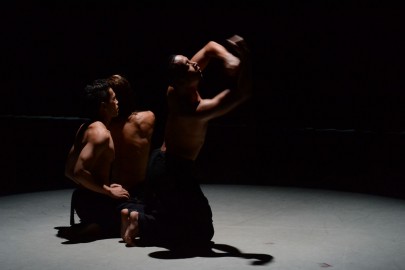
DAY THREE: SUNDAY by Sara Bloomberg
Imagine a blend of ballet where the dancers also use their hands and feet as musical instruments as they float across the stage like nymphs — simultaneously playful, elegant and bold. This is the result of the partnership between Maya Dance Theater of Singapore and ODC Dance in San Francisco: a presentation in three acts called “41 Minutes.” The theater was slightly humid, like a yoga studio, even before the performance began, adding to the tropical feel of the music playing as people took their seats. Even if not intentional, it worked.
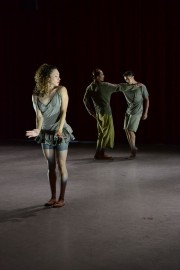
Like an ominous dream, the dancers commanded the stage floor with such ease and expressiveness like a master painter whose brush strokes flow without a second thought. Musical scores ranged from combinations of percussion and synthesizers to more electronic focused overtures that featured tongue-in-cheek vocals, such as, “You don’t know me but I know you,” from Laurie Anderson’s song “O’ Superman,” originally released in 1982. A thumping soundtrack evocative of heartbeats, “O’ Superman” explores the intersection of modern technology and the importance of love and human experiences while the dancers glided slowly around, as if they were moving through jello, lost yet seeking company. We still need touch and genuine connections in a world of cyborgs and artificial intelligence, after all.
Even when the narratives within a piece were separate, the connections between them remained.
This was particularly evident in the second act, “Kuya- (brother)”, where three men — chests bare and wearing identical black pants — moved through loneliness, struggle and their fraternal bonds. As violins played solemnly in the background, the brothers huddled before they parted on solo journeys. They circled around the stage like lost adventures that were unknowingly on similar paths, strife painted across their faces.
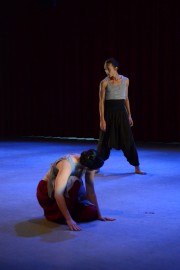
Eventually, they find their way back home, comforted by each others company. With a focus on storytelling through modern dance forms that incorporate elements of ballet and the human body as an instrument, “41 Minutes” only leaves you wanting more.
ZOMBIE APOCALYPSE
Maybe death isn’t the worst fate after all? A group of zombies unwillingly cling onto their existence, manipulated by the musical whims of their mistress in inkBoat’s production of “Exquisite Cucaracha,” presented on July 1 during ODC Theater’s Walking Distance Festival.
Through alternating periods of stillness and epileptic movements, accompanied by moments of silence, soft notes and chaotic bass-heavy sequences, “Exquisite Cucaracha” explores the lack of agency that occurs when we feel trapped.
Entranced by their mistress as she serenades them with one of Monteverdi’s arias, composed by Gretchen Jude, the zombies twitch and spasm — one with a sinister grin plastered on her face the entire time. “Lasciatemi morire,” their mistress sings — ”Let me die. It is unclear whether she is teasing them or offering solace.
It is a haunting, yet beautiful piece worthy of further exploration, that was cut short by the opening act, “Security,” by Angharad Davies. As an experimental theater/dance piece, “Security” successfully plays with silence and awkwardness but the bright stage and lighter theme seemed out of place next to the dark, brooding sequences of “Exquisite Cucaracha.”
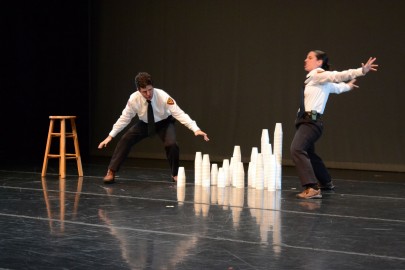
Absent of any musical soundtrack, the performers’ shoes squeaked across the stage floor and keys jingled at their sides whenever they jumped and ran across the stage, styrofoam cups in hand.
Davies turns mundane daily activities, such as drinking coffee and waiting, into exaggerated forms as she and her partner Alex Grant muse about work. Their awkward conversations were punctuated with periods of silence and it was as if they understood each other best not through speech but through movement.
However, the audience was treated to a sneak peak of short film “Veronica and Vincent” by Amy Seiwert before either act began. In the film, a beautiful young couple dances in a green hillside, exploring and embracing each other but still maintaining a certain distance — a scene reminiscent of an old Indian film where the lovers tease the viewers but in the end never kiss. Their moves are poignant and sensual as their bucolic ballet unfolds. Although they are silent, an older woman’s voice projects over them, lending a sadness to the scene as she reflects on her own life, beauty, family and marriage.
All three pieces of the evening were well executed but, like a box full of chocolate truffles, they are better enjoyed one at a time.
Peter Hernandez and Sara Bloomberg are editors at The Guardsman. You can contact them at phernandez@theguardsman.com or @milesof and sbloomberg@theguardsman or @bloomreports.

Comments are closed.